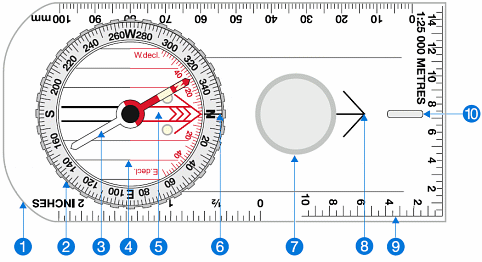Compass Features

The following diagram shows a compass and explains its various features.


- 1. The base plate mounting of the compass, with a ruler for measuring scale.
- 2. The compass housing contains the magnetic needle and has the points of the compass printed on a circular, rotating bezel.
- 3. The compass needle floats on liquid so it can rotate freely, the red end should always point to magnetic north.
- 4. Orienting lines fixed within the compass housing and designed to be aligned with the vertical grid lines on a map. Half the lines are coloured red to indicate north.
- 5. Orienting arrow fixed within the compass housing, aligned to north on the housing.
- 6. The index line fixed within the outer edge of the compass housing as an extension of the direction of travel arrow. It marks the bearing you set by rotating the compass housing.
- 7. Magnifier for detailed map reading.
- 8. The direction of travel arrow shows the direction that you want to travel along or the bearing you are taking. It is fixed parallel to the sides of the base plate and aligned with the fixed index line on the edge of the compass housing (number 6).
- 9. Compass scale displayed along the edge of the base plate so you can measure distances on maps.
- 10. Luminous strip to assist navigation at night.